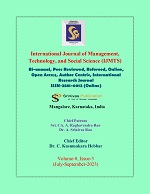The Influence of Gamification on Customer Experience in Digital Banking Practices
Main Article Content
Abstract
Purpose: In a world that increasingly revolves around technology and digital interactions, businesses strive to provide engaging and personalized experiences to their customers. In the realm of banking, this endeavor has given rise to the incorporation of gamification techniques to enhance customer engagement and satisfaction. Gamification, the utilization of game plan standards and mechanics in non-game settings, has arisen as a useful asset in various industries, including digital banking. This article explores the influence of gamification on customer experience in the domain of digital banking practices. The researcher has chosen the topic "The Influence of Gamification on Customer Experience in Digital Banking Practices" to examine how gamification strategies, including badges, points, leaderboards, rewards, progress bars, trivia, opinion polls, and mini-games, are enhancing the competitive edge of private sector banks in Kerala.
Design: In this study, a combination of descriptive and analytical research designs was utilized. Primary data and demographic information were gathered through the administration of a standardized questionnaire to a sample of 150 bank customers. To validate the study and ensure its reliability, a preliminary survey was undertaken, and the Cronbach's Alpha test was used to evaluate the metrics of the study. The amassed data underwent analysis through techniques such as correlation, multiple regression, and tests for multicollinearity to understand the intrinsic relationships and determinants in the research.
Findings/Results: This research offers concrete empirical proof highlighting the profound impact of gamification on the customer experience in digital banking, particularly within the private sector. The study's outcomes reveal that the chosen independent factors, namely badges, points, leaderboards, rewards, progress bars, trivia, opinion polls, and mini-games, collectively play a significant role (accounting for 54% of the variance) in predicting customer experience.
Paper Type: Descriptive and Analytical Research
